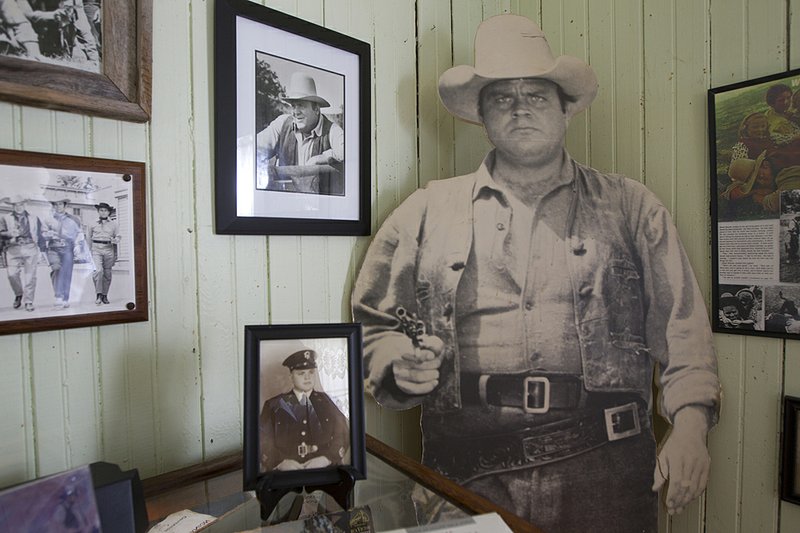McLEAN, Texas — No one can remember whether the brassiere factory on Kingsley Street put up barbed wire to keep intruders out.
These days, hundreds of strands of barbed wire draw people in.
The old factory building in McLean is now home to the Devil’s Rope Museum, a 14,000-square-foot tribute to the history of barbed wire and fencing tools.
It is a wayward cow’s worst nightmare: Bent-corner plate barb, double-plate locked link wire, Bagger’s 1876 barbed single-strand rod and - in the Rare Wire exhibit, protected from the public and overzealous collectors in a glass case - Dodge’s rotating star barb and fixed star on single strand from 1881.
In McLean, a town of about 800 residents east of Amarillo in the Texas panhandle, the museum is a bona fide tourist attraction: Anita Seaney, the curator, said it had 6,000 visitors last year.
“It’s our little contribution to history,” said Seaney, 69, standing near the display of posthole diggers. “We have 500 or 600 different kinds of barbed wire. I haven’t counted. The guy that can probably answer most of your questions lives down around Fort Worth, and he counted them one day, but we didn’t write it down.”
Texans may prize their barbed wire, but they also love their classic-rock eighttrack tapes from the 1970s (the Eight Track Museum in Dallas), their bugs (the Cockroach Hall of Fame Museum in Plano), their cars (the Central Texas Museum of Automotive History in Smithville), their sports (the Texas Basketball Museum in Carmine) and their toilet seats (Barney Smith’s Toilet Seat Art Museum in San Antonio). The state has numerous established, well-financed museums that are members of the American Association of Museums in Washington - the Museum of Fine Arts in Houston, the Museum of Nature and Science in Dallas - but there are dozens of others that exist as museums because people put up signs outside declaring them so.
One thing becomes clear when cataloging the state’s lesser-known museums: Few things fascinate and captivateTexans as much as Texas itself.
There are museums dedicated to Texas regional history (the Central Texas Oil Patch Museum in Luling), Texas weather (the John C. Freeman Weather Museum in Houston), Texas beverages (the Dr Pepper Museum in Waco) and Texas pop culture (Southfork Ranch Gift Store and Museum in Parker, where the Dallas television series was filmed). Cowgirls get their due at the National Cowgirl Museum and Hall of Fame in Fort Worth. A number of museums honor Texas lawmen, but at least one pays homage to its convicts and their keepers: the Texas Prison Museum in Huntsville. And there is one Houstonmuseum that shows no Texas bias, because its subject - death in general, and funerals in particular - is too broad: the National Museum of Funeral History, where visitors can admire late-1800s hearses and a replica of Abraham Lincoln’s walnut casket.
The American Association of Museums officially has 147 Texas museums in its database - California has the most of any state, with 1,070 - but its list includes none of the smaller and more obscure ones, such as the collection of toilet seats in the garage behind Smith’s San Antonio home that he calls his museum.
Each of the 1,005 seats is adorned with artwork painted or crafted by Smith, 90. He cananswer almost any question about the museum, from its hours (“It’s closed now, and it won’t be open until someone says, ‘I’ll be there in 30 minutes,”’ he said) to its organization (“Every one of these that are hanging up have exhibit numbers on them,” he added). But the most important question gives him pause.
“Why am I doing it?” said Smith, who was in the middle of gluing Scrabble tiles to No. 1,006. “Because I wanted to stay busy and keep with my business. I was a plumber.”
At the barbed-wire museum in McLean, admission is free, donations are encouraged, and Seaney went through the trouble recently of buying a new first-aid kit for pinpricks. The museum, which was started by a group of barbed-wire collectors and opened in 1991, survives in part on gift-shop sales. The Barbed Wire Identification Encyclopedia, fifth edition,is $32, and packs of wire samples cost between $3 and $140.
“The motorcycle riders don’t buy it very much, because they don’t have a place to put it,” she said of their merchandise.
One year, Seaney recalled, the museum was the answer to a question on the Jeopardy game show. One of the contestants was from Texas. To Seaney’s amazement, he was unable to guess the answer correctly.
He had never heard of it.
Front Section, Pages 2 on 03/25/2012
